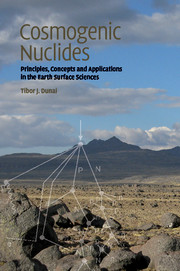Book contents
- Frontmatter
- Contents
- Preface
- 1 Cosmic rays
- 2 Cosmogenic nuclides
- 3 Production rates and scaling factors
- 4 Application of cosmogenic nuclides to Earth surface sciences
- Appendix A Sampling checklist
- Appendix B Reporting of cosmogenic-nuclide data for exposure age and erosion rate determinations
- References
- Index
4 - Application of cosmogenic nuclides to Earth surface sciences
Published online by Cambridge University Press: 29 December 2010
- Frontmatter
- Contents
- Preface
- 1 Cosmic rays
- 2 Cosmogenic nuclides
- 3 Production rates and scaling factors
- 4 Application of cosmogenic nuclides to Earth surface sciences
- Appendix A Sampling checklist
- Appendix B Reporting of cosmogenic-nuclide data for exposure age and erosion rate determinations
- References
- Index
Summary
As introduced inChapter 2, the application of cosmogenic nuclides to Earth surface sciences is a relatively recent affair. In 1986/87 terrestrial in situ cosmogenic nuclides came of age, with eight seminal papers reporting cosmogenic 3He, 21Ne, 22Ne, 10Be, 26Al and 36Cl in terrestrial rocks (Craig and Poreda 1986, Klein et al. 1986, Kurz 1986a, b, Nishiizumi et al. 1986, Phillips et al. 1986, Marti and Craig 1987, Nishiizumi et al. 1987). Since the publication of these pioneering studies, the methodological developments and their applications to Earth surface sciences has taken off impressively (Fig. 4.1). The technique has now clearly left the realm of specialist interest and has become a widely used tool in geomorphology. In fact, the novel ability to use cosmogenic nuclides to date geomorphologic surfaces, and determine process rates from rock, regolith and soils (Lal 1991), has revolutionized and rejuvenated many fields of geomorphology.
In this chapter, the main applications of cosmogenic nuclides will be visited in the following sequence: (i) exposure dating of geologic/geomorphic surfaces, (ii) burial dating, (iv) erosion/denudation rate determinations, (vi) constraining uplift rates and (v) soil dynamics. The methodological basis for each will be provided, along with a discussion of both generic and specific examples. At the end of this chapter, avenues to deal with the inherent methodological and geologic uncertainties will be examined.
Exposure dating
In principle, any geological surface that is stable and continuously exposed to cosmic rays can be dated by measuring the amount of accumulated cosmogenic nuclide in surfacial rocks.
- Type
- Chapter
- Information
- Cosmogenic NuclidesPrinciples, Concepts and Applications in the Earth Surface Sciences, pp. 77 - 143Publisher: Cambridge University PressPrint publication year: 2010
- 3
- Cited by



